|
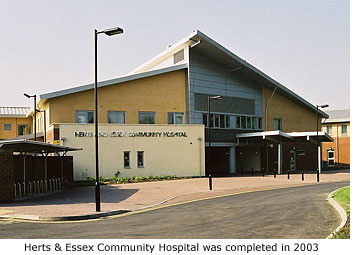 Bishop's Stortford's current population of over 35,000 is now served by a Community hospital, built on vacant land that was once part of the original Herts and Essex Hospital. Bishop's Stortford's current population of over 35,000 is now served by a Community hospital, built on vacant land that was once part of the original Herts and Essex Hospital.
At the start of the Second World War, in 1939, Haymeads Public Assistance Institute (formerly the workhouse) suddenly took on a new and important role as a hospital for the Services. The problem was, its size was less than adequate for the role it was expected to play, and so rows of huts were rapidly built to act as wards for injured servicemen returning from the front. At first these were only distinguished by overly large letters of the alphabet painted on their side walls, but as the war progressed so too did the hospital, albeit in piece-meal fashion. Added on, as and when required, were operating rooms, dispensary, X-ray facilities and other essential needs including a hut where servicemen could be entertained by ENSA (Entertainments National Service Association).
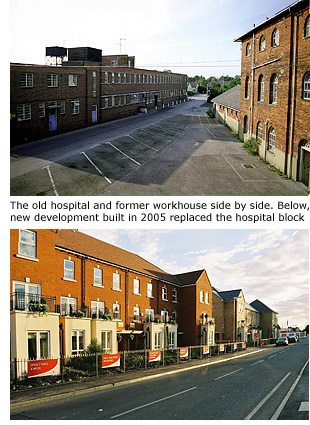 Throughout the five years of war the only surgeon in regular attendance was Dr Robert Wallace, a local practitioner from North Street (See Guide 6), and ancillary medical staff were provided by the London Hospital and Prince of Wales Hospital. The wards, eventually housing over 900 beds and linked by a corridor a quarter-of-a-mile long, were intended only as temporary accommodation for the duration of the war, but brought about a hospital site that was to serve the town and local area well into the 1980s. Throughout the five years of war the only surgeon in regular attendance was Dr Robert Wallace, a local practitioner from North Street (See Guide 6), and ancillary medical staff were provided by the London Hospital and Prince of Wales Hospital. The wards, eventually housing over 900 beds and linked by a corridor a quarter-of-a-mile long, were intended only as temporary accommodation for the duration of the war, but brought about a hospital site that was to serve the town and local area well into the 1980s.
Although Haymeads continued as a Public Assistance Institute after the war, a shift in the local population soon became cause for concern. Constant staff shortages led to the closure of several wards and the hospital gradually became run down. Its saviour came in 1948 with the creation of the National Health Service. Designated a general hospital and renamed Herts and Essex Hospital, it was then managed by the Hertford Group Hospital committee. At one stage the hospital provided 1,900 beds but when the old workhouse was closed soon after, every effort was then made to expand and improve services – including a new accident and emergency theatre and an eye unit. By the mid 1980s, however, a change in the political and economic climate inevitably led to cutbacks in the NHS, and a proposal was made to turn it into a community hospital.
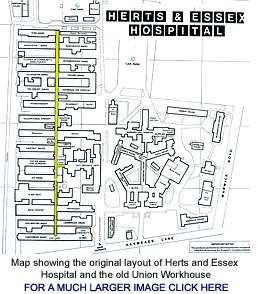 In November 1990 the minor casualty department closed because of financial constraints, but that same month the hospital was at the centre of a national political story when future prime minister, John Major, on the eve of the election which ousted Margaret Thatcher from office, was admitted to have an infected wisdom tooth removed – courtesy of the NHS. He cast his vote by proxy then left the following day to recuperate at his home near Huntingdon. Despite a lengthy campaign by the public to prevent closure, including a petition containing 20,000 signatures, many services were systematically shut down and by April 1995 all acute in-patient services had been centralised at Princess Alexandra Hospital, Harlow. In November 1990 the minor casualty department closed because of financial constraints, but that same month the hospital was at the centre of a national political story when future prime minister, John Major, on the eve of the election which ousted Margaret Thatcher from office, was admitted to have an infected wisdom tooth removed – courtesy of the NHS. He cast his vote by proxy then left the following day to recuperate at his home near Huntingdon. Despite a lengthy campaign by the public to prevent closure, including a petition containing 20,000 signatures, many services were systematically shut down and by April 1995 all acute in-patient services had been centralised at Princess Alexandra Hospital, Harlow.
Community services began to increase in 1994, including a GP practice, Chiropody service and children’s services, and after much delay work on a new community hospital finally began in 2001 – a £14m project to include 68 beds, an outpatients department and many other services. On completion in 2003, the building contractor took on responsibility for maintenance, management and all non-clinical services for a period of 30 years. At the end of that time they will revert to NHS control.
In November 2003 permission was granted for the building of 230 new houses on the site of the old hospital, and for the workhouse and associated Rutherford House to be renovated and refurbished to accommodate a total of 34 apartments.
In 1934 the Unemployment Insurance Bill came into force, meaning that unemployment assistance rates were now set at a national level and could not be influenced locally. In protest of the bill, the National Unemployed Workers Movement (NUWM) organised 17 regional contingencies from all over Britain to march on London. This included 90 marchers from Tyneside, the youngest of whom was 15.
Leaving Newcastle on 1 February, one of their many stops along the 250 mile route was Bishop's Stortford, arriving here Tuesday 20 February. Food and refreshment was given and accommodation offered at Haymeads Institution. This the marchers refused, choosing instead to rest the night at St Michael's and Holy Trinity parish halls.
Another little known fact is that in April 1934 the hospital made special use of its tennis court by holding exhibition matches attended by the Davis Cup team of the day. This included the great Fred Perry. Having just won the American and Australian championships, Perry was forecast to win Wimbledon that year, which he did – and the next year, and the next.
Read David Hanscomb's memories of Herts & Essex Hospital between 1957 and 1960 on Guide 10 of the Memories page
|
|
The site of the present car showroom near to the corner of Warwick Road and Dunmow Road was once that of the Fox Brewery. First owned by J.R. Heath, 1886-1890, it passed to Henry Cooper in 1895. Flinn & Sons owned it in 1899, selling it to W.R. Stanton in 1902 for £2,300. That same year, and again in 1910, it is recorded as being owned by the Bailey Brothers. In 1915 their brewery and one off-licence was taken over by Benskins Brewery.
|
|
The road named Stortford Hall Park is derived from ‘Stortford Hall’ and ‘Bishops Park’; both references to the time when the Manor of Stortford was owned by the bishop of London.
Stortford Hall was built near to this point (within the Bishops Park) in the early 17th century and is assumed to have been a replacement home for the Rector of Bishop’s Stortford, whose previous house (Rectory Manor House) was the subject of lease and sub-lease by the Bishop, Queen Elizabeth I, and Edward Denny.
This assumption is made because Stortford Hall is known to have originally been owned by the Precentor of St Paul’s and he, being the holder of the manor, had always nominated an official (the Rector) to live here and run the manor for him.
Stortford Hall Farm, which was also in this area and a tenancy of the manor, may well have been built at the same time as Stortford Hall, if not it was certainly named after it. At the beginning of the 18th century, records show that both were held by Dr William Stanley, the Precentor of St Paul’s, and that when he died in 1727 their individual leases were sold to private ownership for £13 13s. (£13 65p).
The properties then changed hands several times and in the late 1800s were owned by William Waylett. Both buildings, originally built of timber and plaster but later refaced with brick, were finally demolished in the early 20th century.
|


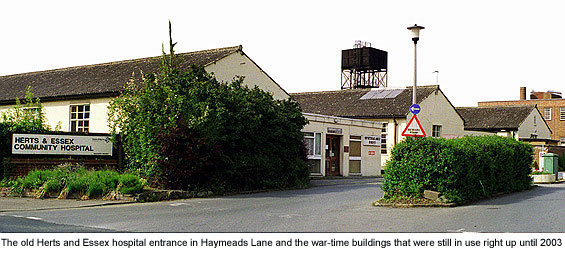

 Bishop's Stortford's current population of over 35,000 is now served by a Community hospital, built on vacant land that was once part of the original Herts and Essex Hospital.
Bishop's Stortford's current population of over 35,000 is now served by a Community hospital, built on vacant land that was once part of the original Herts and Essex Hospital. Throughout the five years of war the only surgeon in regular attendance was Dr Robert Wallace, a local practitioner from North Street (See Guide 6), and ancillary medical staff were provided by the London Hospital and Prince of Wales Hospital. The wards, eventually housing over 900 beds and linked by a corridor a quarter-of-a-mile long, were intended only as temporary accommodation for the duration of the war, but brought about a hospital site that was to serve the town and local area well into the 1980s.
Throughout the five years of war the only surgeon in regular attendance was Dr Robert Wallace, a local practitioner from North Street (See Guide 6), and ancillary medical staff were provided by the London Hospital and Prince of Wales Hospital. The wards, eventually housing over 900 beds and linked by a corridor a quarter-of-a-mile long, were intended only as temporary accommodation for the duration of the war, but brought about a hospital site that was to serve the town and local area well into the 1980s.
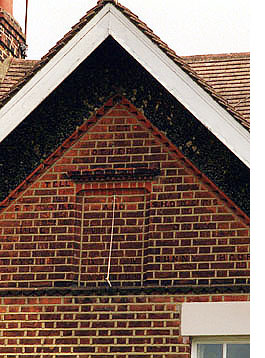 Britain’s obsession with the weather seems to have been as familiar at the end of the 19th century as it is now. On the gable of a private house in Dunmow Road (No 67), a sundial is the centre-piece of a short verse etched into the original brickwork. It reads:
Britain’s obsession with the weather seems to have been as familiar at the end of the 19th century as it is now. On the gable of a private house in Dunmow Road (No 67), a sundial is the centre-piece of a short verse etched into the original brickwork. It reads: